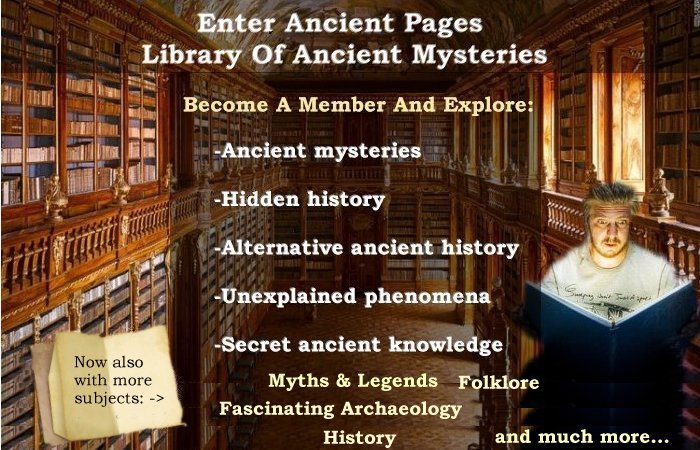Are you ready to explore more of Ancient Pages? On April 6, 2018, we launched our member section, and we are adding premium content regularly.
If you’re interested in ancient mysteries, hidden history, alternative history, unexplained phenomena, secret ancient knowledge, forgotten lore, myths, and legends, fascinating archaeology news, interesting ancient facts, and more, you’ve come to the right place.
We are a reader-funded, independent news website. We have never been supported by any company or organization. Instead, we rely on our wonderful readers who, by becoming premium members, enable us to publish fascinating content.
Join our readers and us!
Subscriptions from just 5 USD/month (when you choose a yearly package)!
Our premium articles are well-researched, written objectively, and suited for readers who want thought-provoking, exclusive, quality content.
As a member, you have complete access to all our articles.
This is how it works:
- Select a subscription package that suits you and click on the yellow subscription button below – (you can cancel the autorenewal at any time, but there are no refunds on subscriptions)
- Once you complete the subscription signup process at PayPal and pay, we will get a notification that you have bought a subscription package. Our admin creates an account for you and sends you an email with a username and password so you can log in to the members' area.
- Please save the welcome email - it contains instructions on how to log in to the members' area.
Subscription Packages To Our Library:
Bronze - Premium Member - 8 USD / Month
Silver - Premium Member - 35.00 USD / 6 months
Gold - Premium Member - 60.00 USD / year
 Our Gift Cards
Our Gift Cards
Do you want to make someone happy or treat yourself?
Consider purchasing a gift card for full access to the Ancient Pages Library of Ancient and Unexplained Mysteries, along with all our premium content. Buy a gift card here
All subscriptions- except gift cards - are set to auto-renew, and you can cancel at any time.
We process all payments, including payment cards, through PayPal - it's fast, simple and secure!
![]()
If you have any questions, don’t hesitate to contact us at editor@messagetoeagle.com or lloyd@messagetoeagle.com
All subscription questions are handled by our sister site MessageToEagle.com that our readers are very familiar with.
As a premium member, you get:
- Access to all our premium articles.
- Extended Search Functionality – Ancient Pages offers thousands of articles. As a member, you can search for topics of interest across all articles. Non-members get much fewer search results than members accessing the entire site.
- Possibility to vote for your favorite subjects and make suggestions to influence publications.
- No ads
- Hundreds of book recommendations and journals to explore topics of your interest further.
- Our premium articles are significantly longer than our free content.
- Lifetime offer - We never raise subscription prices for existing members! By subscribing now, you secure a lifetime offer that guarantees your subscription price will never increase.
Enjoy the reading, and we look forward to welcoming you as a valued Ancient Pages member.
Regards,
Ellen Lloyd with the team
Author, researcher, and owner of Ancient Pages.com and MessageToEagle.com
For the curious mind: More information about our library
Why do we charge for premium content?
It's simple. We write for a living, and no one wants to work for free. Would you like to go to work and not get paid? Hardly.
As a reader-funded, independent news website, we pride ourselves on our autonomy and integrity. Unlike many others, we have never been backed by any company or organization. This independence is made possible by our incredible readers who choose to become premium members.
By joining them, you empower us to continue delivering fascinating content that remains unbiased and true to its purpose. Your support is crucial in maintaining the quality and freedom of the information you value.
Thousands of articles on Ancient Pages will remain free, but premium content is exclusively available to our members.
Our premium content is for those who are truly curious about humanity’s mysterious ancient past and unexplained mysteries. There are many ancient mysteries that orthodox science cannot explain, and we think it’s also important to present an alternative view of ancient historical events. We also publish fascinating educational content, myths, legends, history, and archaeological discoveries.
Our popular library of ancient and unexplained mysteries
We publish premium articles regularly, and our library contains hundreds of mysteries. Our “trust policy” is simple and straightforward. Premium members trust us and pay to access the content. They support our site and are seriously interested in our work. We return that trust by regularly publishing premium articles and all the other free articles we publish daily.
Check out our:
Library Of Ancient & Unexplained Mysteries - here
Our huge library of ancient & unexplained mysteries is packed with fascinating information.
What you get as a member
Many of our premium articles are controversial in nature, and that's the point because we encourage our readers to think and explore all possibilities. To understand the past, one must remain open-minded. We believe our readers are interested in examining various possibilities that could shed light on some of the greatest mysteries of the past.
We investigate unsolved ancient mysteries, hidden history, lost lands, forgotten lore, unexplained phenomena, remarkable ancient technology, secret ancient knowledge, incredible ancient civilizations, perplexing artifacts, fascinating myths, and legends.
Our articles are meticulously crafted from information sourced from books and magazines, ensuring a depth of knowledge that is hard to find on internet pages. We go the extra mile by providing our readers with curated book recommendations, enabling them to delve deeper into their topics of interest. This is our commitment to fostering a culture of continuous learning and exploration.
We also compare scientific discoveries with unorthodox theories, and it is up to our readers to form an opinion.
What some of our readers say:
"I decided to become a member of a reader-supported site because I truly value the premium content it offers. In today's world, quality often comes at a price, and I'm willing to invest in that. It's evident that the team at Ancient Pages is passionate about their work and committed to providing readers with the best and most valuable content available. I have learned so much here! The images are also exceptional. I no longer need to search across multiple sites for news and articles because everything I need is right here, saving me precious time. Please continue your excellent work! " - Mark, Kent, UK
"I'm absolutely thrilled with my premium subscription! It's been such a joy to immerse myself in ad-free reading and explore the full range of content available. The mysteries are captivating, and I'm so grateful for the wonderful book recommendations. This subscription has truly enhanced my reading experience, and I appreciate the value it brings to my daily life." - Kerry, North Carolina, United States
"Why I bought a subscription? Simple! I love the content here and I want to support Ancient Pages. Keep up the good work guys! I learn so much here! Happy to have become a premium member! - Julia, Cotswolds, United Kingdom
Reading Ancient Pages is nowadays my daily routine. This site gives me so much delight and being a mystery lover I naturally couldn't resist trying the library with all these ancient and unexplained mysteries. I'm happy I became a member cause it's a very large library with tons of remarkable mysteries. Ancient Pages is simply a must-read!" - Keily, Edmonton, Canada
"I'm a great fan of Ellen Lloyd and love reading her articles. When it comes to ancient mysteries and anything that remains unexplained she's the best guide one can get. She takes you to places you never thought existed and she picks the best and most curious mysteries. Anyone who loves mysteries will enjoy these articles. I love this library and Ancient Pages is my favorite site. Love being an Ancient Pages member!" - Anthony, Oklahoma, USA
"Excellent and informative articles! Great book recommendations! I enjoy everything Ancient Pages publishes! - Marcus, Texas, USA
"To me personally, Ancient Pages is the most interesting and reliable site covering history. The fact that all articles are always written by the same authors, appeals to me. As a reader I find it easier to follow the thoughts of the author." - Angela, California, USA
"The site’s vast archive offers us, readers, plenty of information on a variety of topics. Mythology, history, mysteries, and pure facts, there is everything here. I look forward to every newsletter and I have long searched for a site like this one. Very happy to have finally found Ancient Pages and I enjoy my time spent here, reading in peace. Thank you for your outstanding work. By signing up as a member I know I contributed to making Ancient Pages stronger and able to produce more outstanding articles. At the same time, the premium articles I now have access to give me so many interesting things to think about. Being a history nerd for years, I can assure everyone this site is truly outstanding!" - Andrew, Ohio, USA
"Simply the best ancient history site on the net! The library of ancient and unexplained mysteries is superb! Love your work and visit all the time!" - James, New York, USA
"Just wow! This is the best and most interesting ancient history site I’ve ever visited. Their ancient mysteries library is remarkable! I love Ancient Pages because they’ve outstanding writers, offer us credible information and the best of ancient history, archaeology, ancient mysteries, mythology, unexplained mysteries, not to mention they give educational topics too. They are simply the best and I recommend everyone to become a member and support their work. I said it once and I’ll say it again. Ancient Pages is the best site and I love reading here!" - Stephen, Denver, USA
"People who write for Ancient Pages love their work and have knowledge about the subjects they cover. I can see it and that’s why they’re so good and the articles are so interesting. I like all your articles very much. Merci beaucoup!" - Clément, Paris, France
"I love the premium articles! They’re packed with info and I’ve learned so much! Ellen Lloyd is a remarkable writer and researcher. One of the best in the field! Signing up for membership was a wonderful thing to do! Ancient Pages is a great ancient history site and I visit every day." - Jamie, Ohio, USA
"As a reader of Message To Eagle I never hesitated to become an Ancient Pages member. The all-in-one newsletter gives me all the news I need, science and ancient history. I don’t feel I have to visit several sites daily cause these guys deliver the best stuff right into my mailbox. Keep up the excellent work, folks!" - Tom, Washington, USA
"Ellen Lloyd is astonishing and so is her entire team. Both sites, Ancient Pages and Message To Eagle are outstanding! What I especially like is the surprise moment! Makes me feel like a child on Christmas Eve. The premium articles are full of fascinating surprises. Ellen doesn’t promote any idea or theory, she simply gives us valuable information and mind you, there were times when I spent hours thinking about what I just read!
I’m so happy I found this wonderful site and decided to become a member!" - Mark, Nottingham, UK
"As a historian, I must confess I was a bit cautious and didn’t know if I should join or not, but I did, and I don’t regret it for a minute! Yes, some premium articles are controversial, but they offer a new fresh perspective and solutions I never considered. I congratulate everyone at Ancient Pages and thank you for proving us with such interesting articles."
Susan, Oxford, UK
"What can I say? I want more and more! I look forward to every premium article! Everything you publish is beyond my expectation. I’m a proud Ancient Pages member and this is the only site I rely on when it comes to ancient related topics." - Darragh, Kilkenny, Ireland
"This is solid work. No sensationalism, good solid research! Highly recommended!"- Andreas, Copenhagen, Denmark
"For as long as I can remember, I have been interested in ancient mysteries. Ellen Lloyd and Ancient Pages give me a chance to explore places and events I never knew existed. I’m very thankful for the reading recommendations, and I think it’s superb that all articles are based on books. Most sites just re-write everything from each other. When I read these premium articles, I know the subject is well-researched and I can continue to investigate and learn more if I want.
I appreciate all the articles I can read. Thank you!" - Magda, Warsaw, Poland
"Hey, no one likes to pay on the internet, but if I must pay for a subscription, Ancient Pages is the winner! The content is awesome!
Their customer support is very good too. Friendly and fast people! I feel at home here." - Steven, Massachusetts, USA
"I became a member the first day they offered premium articles. I know Ancient Pages and MessageToEagle – these guys deliver what they promise! Great content to say the least!" - Henrik, Stockholm, Sweden
"Personally, I wish to read just one or two authors. Reading articles by many authors is confusing. They all have their own opinions, contradict each other and the content doesn’t make sense. So, I was in heaven when I found Ancient Pages. I love Ellen’s articles. She is professional, and I prefer to pay and read excellent quality content. I don’t have time to google and visit many other sites. Ancient Pages has become my ultimate resource for ancient topics. They have everything I need and it’s a fantastic site.
Five stars without hesitation."- Caroline, Florida, USA
"The one and only ancient history site I need. The premium library is awesome!" - Anthony, Virginia, United States




